Fiber Bragg Grating with Enhanced Cladding Modes Inscribed by Femtosecond Laser and a Phase Mask
Abstract
1. Introduction
2. Fabrication and Characterization
3. Experiments and Discussions
3.1. Vector Twist
3.2. Refractive Index
3.3. Temperature
4. Conclusions
Author Contributions
Funding
Conflicts of Interest
References
- Eggleton, B.; Westbrook, P.; White, C.A.; Kerbage, C.; Windeler, R.S.; Burdge, G.L. Cladding-Mode-resonances in air-silica microstructure optical fibers. J. Light. Technol. 2000, 18, 1084–1100. [Google Scholar] [CrossRef]
- Pang, F.F.; Liang, W.B.; Xiang, W.C.; Chen, N.; Zeng, X.L.; Chen, Z.Y.; Wang, T.Y. Temperature-insensitivity bending sensor based on cladding-mode resonance of special optical fiber. IEEE Photon. Technol. Lett. 2009, 21, 76–78. [Google Scholar] [CrossRef]
- Bao, W.J.; Qiao, X.G.; Rong, Q.Z. Fiber-optic vector accelerometer using orthogonal Bragg grating inscription over innermost cladding of a multi-clad fiber. J. Light. Technol. 2019, 37, 2706–2712. [Google Scholar] [CrossRef]
- Ascorbe, J.; Corres, J.; Matias, I.; Arregui, F. High sensitivity humidity sensor based on cladding-etched optical fiber and lossy mode resonances. Sens. Actuators B Chem. 2016, 233, 7–16. [Google Scholar] [CrossRef]
- Zhou, W.J.; Zhou, Y.; Dong, X.Y.; Shao, L.Y.; Cheng, J.; Albert, J. Fiber-optic curvature sensor based on cladding-mode Bragg grating excited by fiber multimode interferometer. IEEE Photon. J. 2012, 4, 1051–1057. [Google Scholar] [CrossRef]
- Ma, Y.; Qiao, X.G.; Guo, T.; Wang, R.H.; Zhang, J.; Weng, Y.Y.; Rong, Q.Z.; Hu, M.L.; Feng, Z.Y. Reflective fiber-optic refractometer based on a thin-core fiber tailored Bragg grating reflection. Opt. Lett. 2012, 37, 323–325. [Google Scholar] [CrossRef]
- Rong, Q.Z.; Qiao, X.G.; Zhang, J.; Wang, R.H.; Hu, M.L.; Feng, Z.Y. Simultaneous measurement for displacement and temperature using fiber Bragg grating cladding mode based on core diameter mismatch. J. Light. Technol. 2012, 30, 1645–1650. [Google Scholar] [CrossRef]
- Bao, W.J.; Hu, N.F.; Qiao, X.G.; Rong, Q.Z.; Wang, R.H.; Yang, H.Z.; Yang, T.T.; Sun, A. High-temperature properties of a thin-core fiber MZI with an induced refractive index modification. IEEE Photon. Technol. Lett. 2016, 28, 2245–2248. [Google Scholar] [CrossRef]
- Han, M.; Guo, F.W.; Lu, Y.F. Optical fiber refractometer based on cladding-mode Bragg grating. Opt. Lett. 2010, 25, 399–401. [Google Scholar] [CrossRef]
- Enríquez, D.A.C.; Cruz, A.R.; Giraldi, M.T.M.R. Hybrid FBG–LPG sensor for surrounding refractive index and temperature simultaneous discrimination. Opt. Laser Technol. 2012, 44, 981–986. [Google Scholar] [CrossRef]
- Albert, J.; Shao, L.Y.; Caucheteur, C. Tilted fiber Bragg grating sensors. Laser Photon. Rev. 2013, 7, 83–108. [Google Scholar] [CrossRef]
- Guo, T.; Liu, F.; Guan, B.O.; Albert, J. Tilted fiber grating mechanical and biochemical sensors. Opt. Laser Technol. 2016, 78, 19–33. [Google Scholar] [CrossRef]
- Guo, T.; Liu, F.; Shao, L.Y. Tilted fiber Bragg grating sensors. J. Appl. Sci. 2018, 36, 75–101. [Google Scholar]
- Zhang, Z.C.; Guo, T.; Guan, B.O. Reflective fiber-optic refractometer using broadband cladding mode coupling mediated by a tilted fiber Bragg grating and an in-fiber mirror. J. Light. Technol. 2019, 37, 2815–2819. [Google Scholar] [CrossRef]
- Caucheteur, C.; Guo, T.; Liu, F.; Guan, B.O.; Albert, J. Ultrasensitive plasmonic sensing in air using optical fibre spectral combs. Nat. Commun. 2016, 7, 13371. [Google Scholar] [CrossRef]
- Chen, C.; Yu, Y.S.; Yang, R.; Wang, C.; Guo, J.C.; Xue, Y.; Chen, Q.D.; Sun, H.B. Reflective optical fiber sensors based on tilted fiber Bragg gratings fabricated with femtosecond laser. J. Light. Technol. 2013, 31, 455–460. [Google Scholar] [CrossRef]
- Wang, R.Z.; Si, J.H.; Chen, T.; Yan, L.H.; Cao, H.J.; Pham, X.T.; Hou, X. Fabrication of high-temperature tilted fiber Bragg gratings using a femtosecond laser. Opt. Express 2017, 25, 23684–23689. [Google Scholar] [CrossRef]
- Ioannou, A.; Theodosiou, A.; Caucheteur, C.; Kalli, K. Direct writing of plane-by-plane tilted fiber Bragg gratings using a femtosecond laser. Opt. Lett. 2017, 42, 5198–5201. [Google Scholar] [CrossRef]
- Pham, X.T.; Si, J.H.; Chen, T.; Qin, F.H.; Hou, X. Wide range refractive index measurement based on off-axis tilted fiber Bragg gratings fabricated using femtosecond laser. J. Light. Technol. 2019, 37, 3027–3034. [Google Scholar] [CrossRef]
- Grobnic, D.; Smelser, C.W.; Mihailov, S.; Walker, R.B.; Lu, P. Fiber Bragg gratings with suppressed cladding modes made in SMF-28 with a femtosecond IR laser and a phase mask. IEEE Photon. Technol. Lett. 2004, 16, 1864–1866. [Google Scholar] [CrossRef]
- Thomas, J.; Jovanovic, N.; Becker, R.G.; Marshall, G.D.; Withford, M.J.; Tünnermann, A.; Nolte, S.; Steel, M.J. Cladding mode coupling in highly localized fiber Bragg gratings: Modal properties and transmission spectra. Opt. Express 2011, 19, 325–341. [Google Scholar] [CrossRef] [PubMed]
- Bao, W.J.; Qiao, X.G.; Rong, Q.Z.; Hu, N.F.; Yang, H.Z.; Feng, Z.Y.; Hu, M.L. Sensing characteristics for a fiber Bragg grating inscribed over a fiber core and cladding. IEEE Photon. Technol. Lett. 2015, 27, 709–712. [Google Scholar] [CrossRef]
- Guo, T.; Shang, L.B.; Liu, F.; Wu, C.; Albert, J. Polarization-maintaining fiber-optic-grating vector vibroscope. Opt. Lett. 2013, 38, 531–533. [Google Scholar] [CrossRef] [PubMed]
- Zhou, K.M.; Zhang, L.; Chen, X.F.; Bennion, I. Optic sensors of high refractive-index responsivity and low thermal cross sensitivity that use fiber Bragg gratings of >80° tilted structures. Opt. Lett. 2006, 31, 1193–1195. [Google Scholar] [CrossRef] [PubMed]
- Yan, Z.J.; Wang, H.S.; Wang, C.L.; Sun, Z.Y.; Yin, G.L.; Zhou, K.M.; Wang, Y.S.; Zhao, W.; Zhang, L. Theoretical and experimental analysis of excessively tilted fiber gratings. Opt. Express 2016, 24, 12107–12115. [Google Scholar] [CrossRef] [PubMed]
- Shao, L.Y.; Xiong, L.Y.; Chen, C.K.; Laronche, A.; Albert, J. Directional bend sensor based on re-grown tilted fiber Bragg grating. J. Light. Technol. 2010, 28, 2681–2687. [Google Scholar] [CrossRef]
- Wang, R.L.; Li, Z.H.; Chen, X.; Hu, N.; Xiao, Y.G.; Li, K.W.; Guo, T. Mode splitting in ITO-nanocoated tilted fiber Bragg gratings for vector twist measurement. J. Light. Technol. 2020. [Google Scholar] [CrossRef]
- Chen, X.Y.; Xu, J.; Zhang, X.J.; Guo, T.; Guan, B.O. Wide range refractive index measurement using a multi-angle tilted fiber Bragg grating. IEEE Photon. Technol. Lett. 2017, 29, 719–722. [Google Scholar] [CrossRef]
- Wang, T.; Liu, K.; Jiang, J.F.; Xue, M.; Chang, P.X.; Liu, T. Temperature-insensitive refractive index sensor based on tilted moiré FBG with high resolution. Opt. Express 2017, 25, 14900–14909. [Google Scholar] [CrossRef]
- Abdukerim, N.; Grobnic, D.; Hnatovsky, C.; Mihailov, S.J. High-temperature stable fiber Bragg gratings with ultrastrong cladding modes written using the phase mask technique and an infrared femtosecond laser. Opt. Lett. 2020, 45, 443–446. [Google Scholar] [CrossRef]
- Abdukerim, N.; Grobnic, D.; Lausten, R.; Hnatovsky, C.; Mihailov, S.J. Complex diffraction and dispersion effects in femtosecond laser writing of fiber Bragg gratings using the phase mask technique. Opt. Express 2019, 27, 32536–32555. [Google Scholar] [CrossRef] [PubMed]
- González-Vila, Á.; Ioannou, A.; Loyez, M.; Debliquy, M.; Lahem, D.; Caucheteur, C. Surface plasmon resonance sensing in gaseous media with optical fiber gratings. Opt. Express 2018, 43, 2308–2311. [Google Scholar] [CrossRef] [PubMed]
- Chah, K.; Kinet, D.; Caucheteur, C. Negative axial strain sensitivity in goldcoated eccentric fiber Bragg gratings. Sci. Rep. 2016, 6, 38042. [Google Scholar] [CrossRef] [PubMed]
- Theodosiou, A.; Kalli, K.; Caucheteur, C. Higher-order cladding mode excitation of femtosecond-laser-inscribed tilted FBGs. Opt. Lett. 2018, 43, 2169–2172. [Google Scholar]
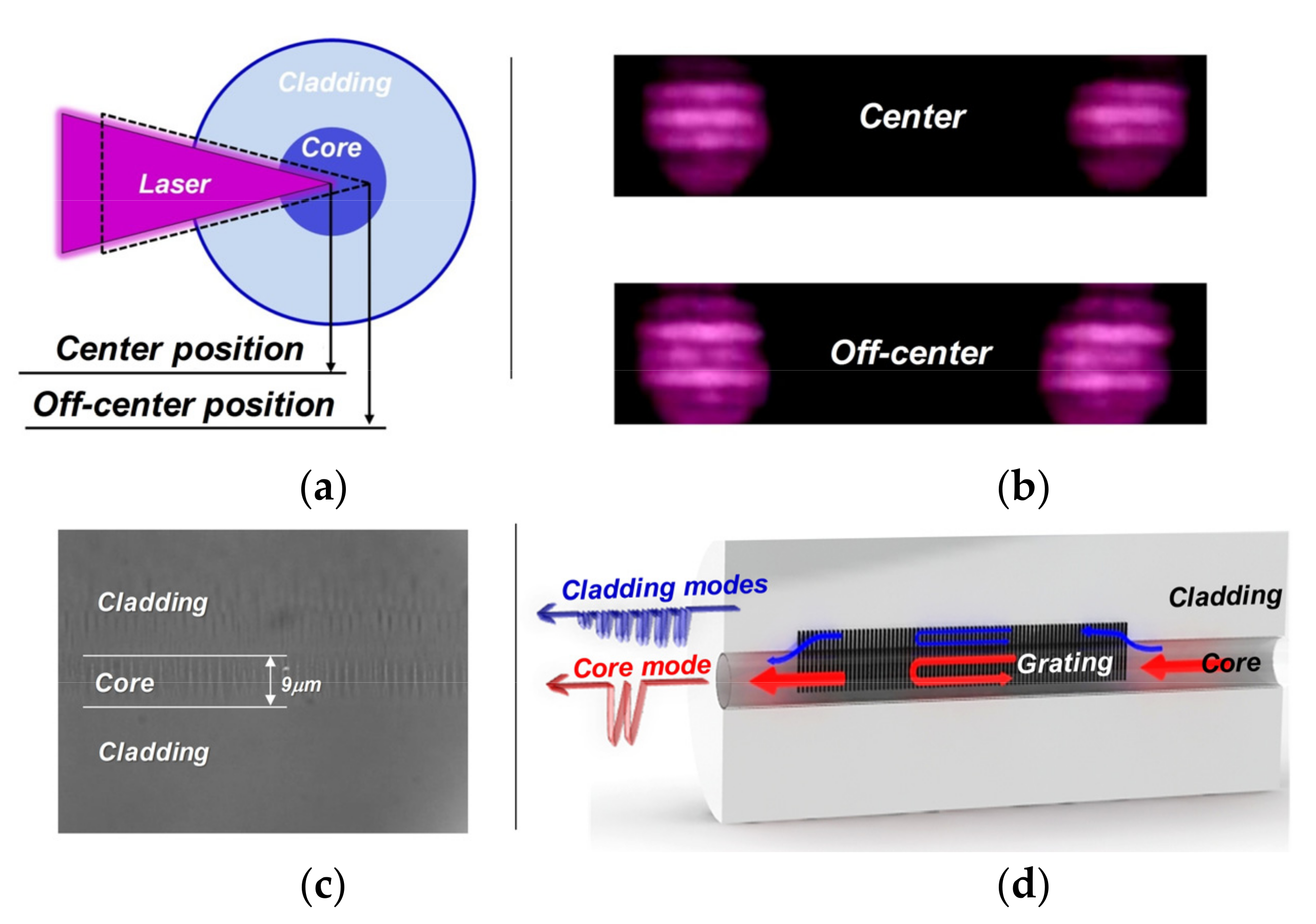
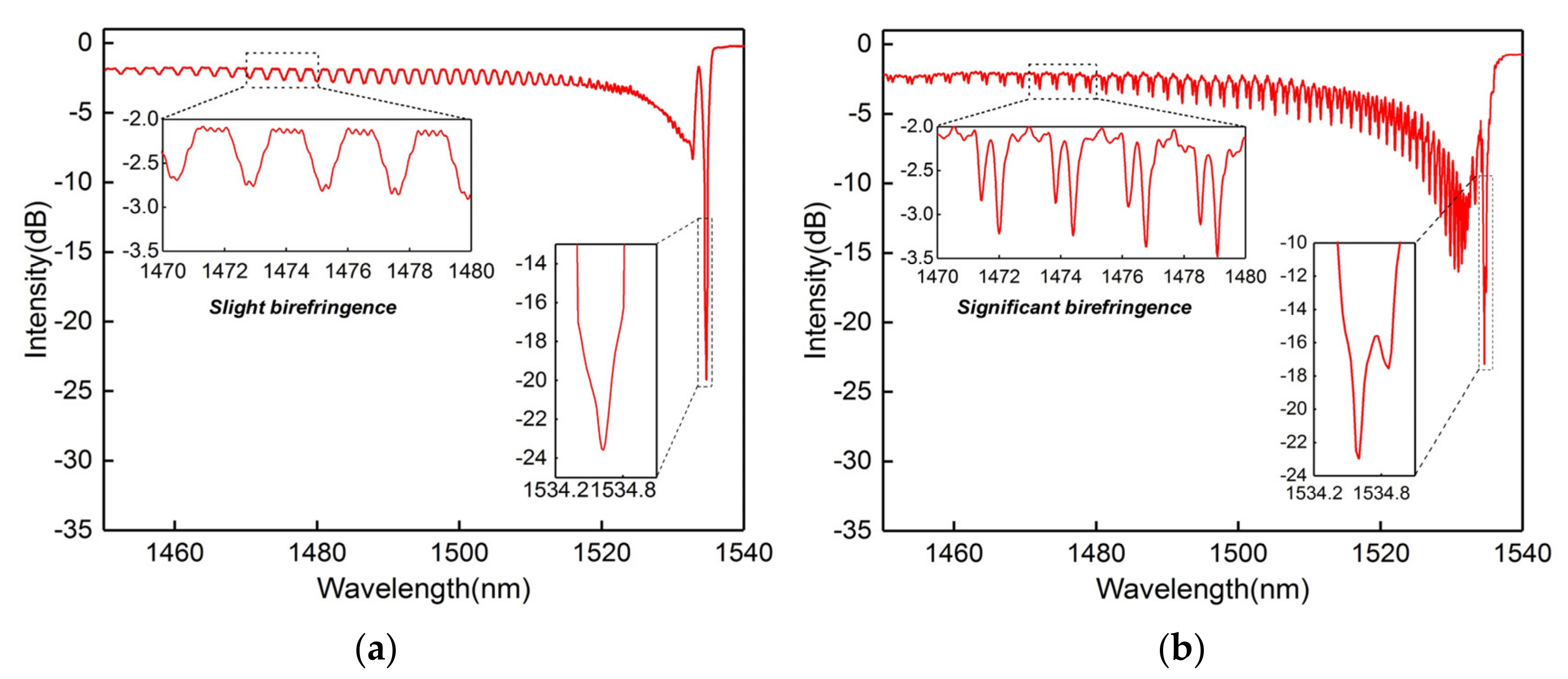
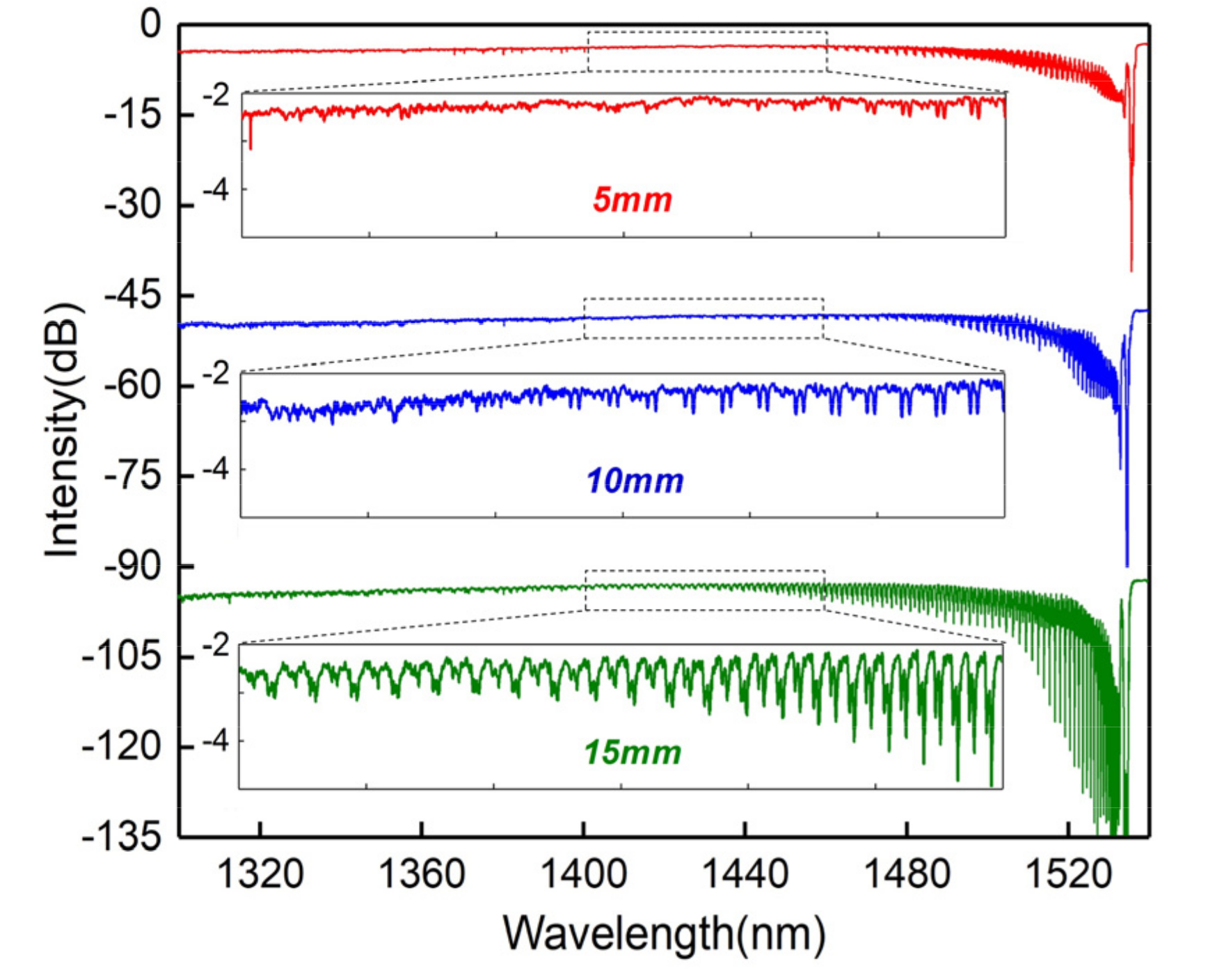
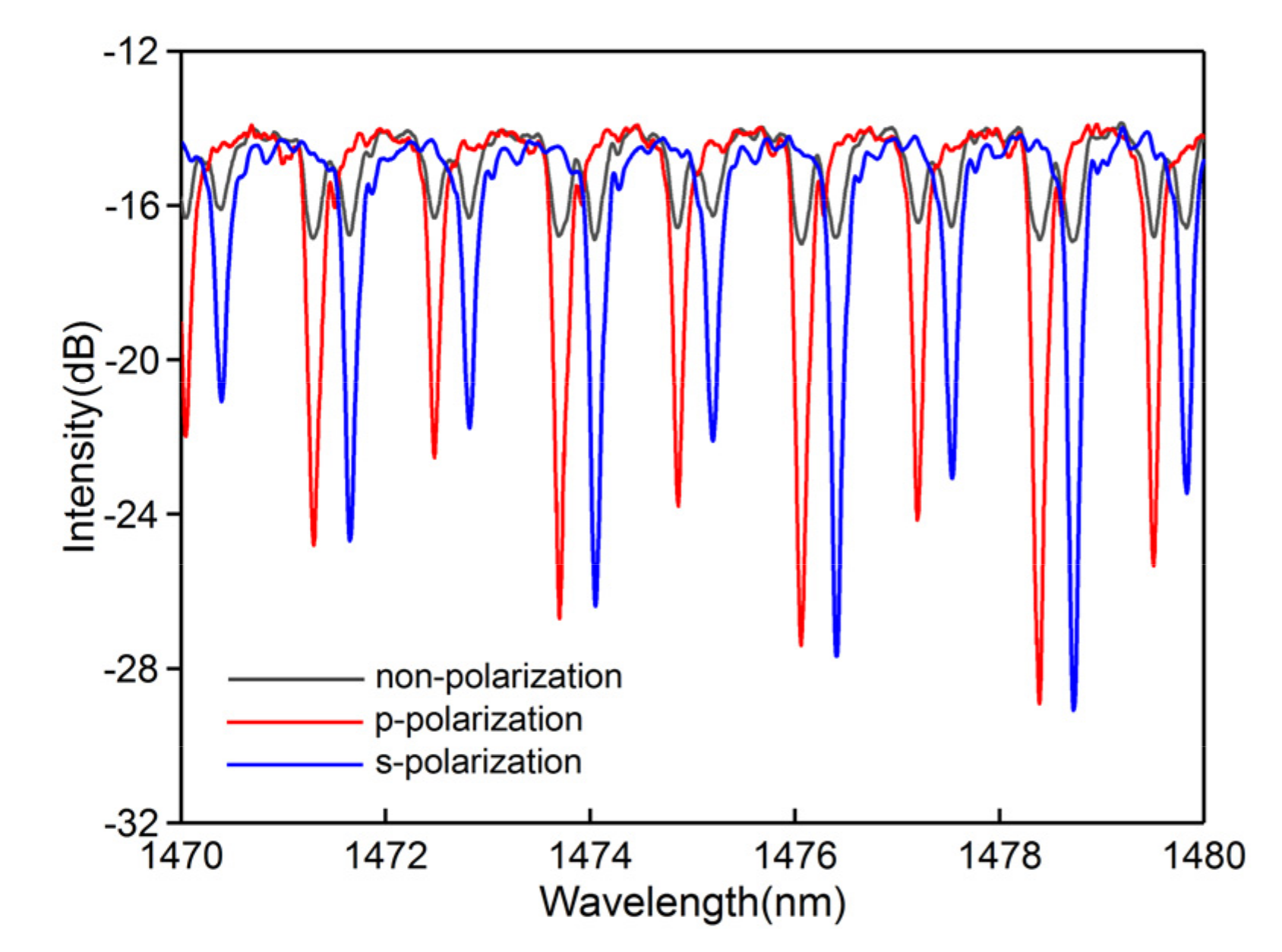

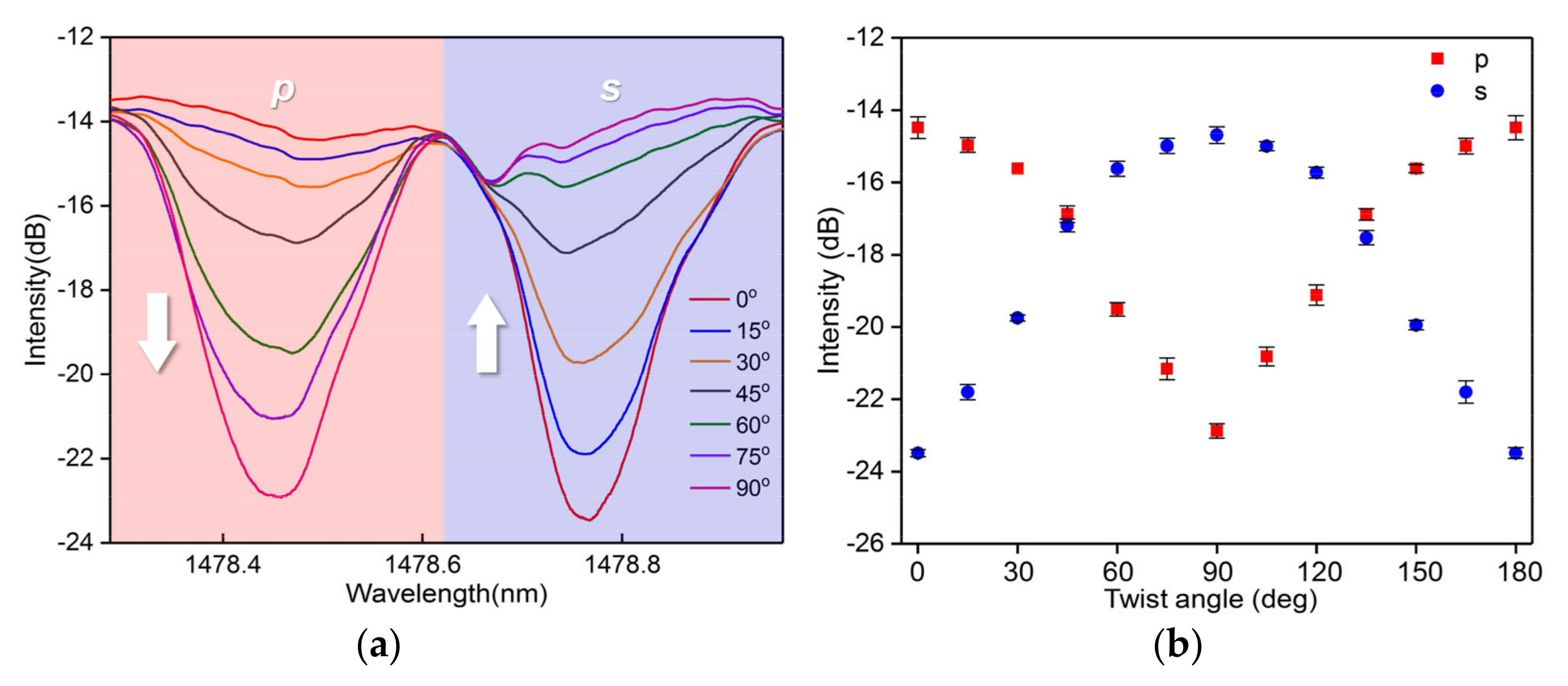
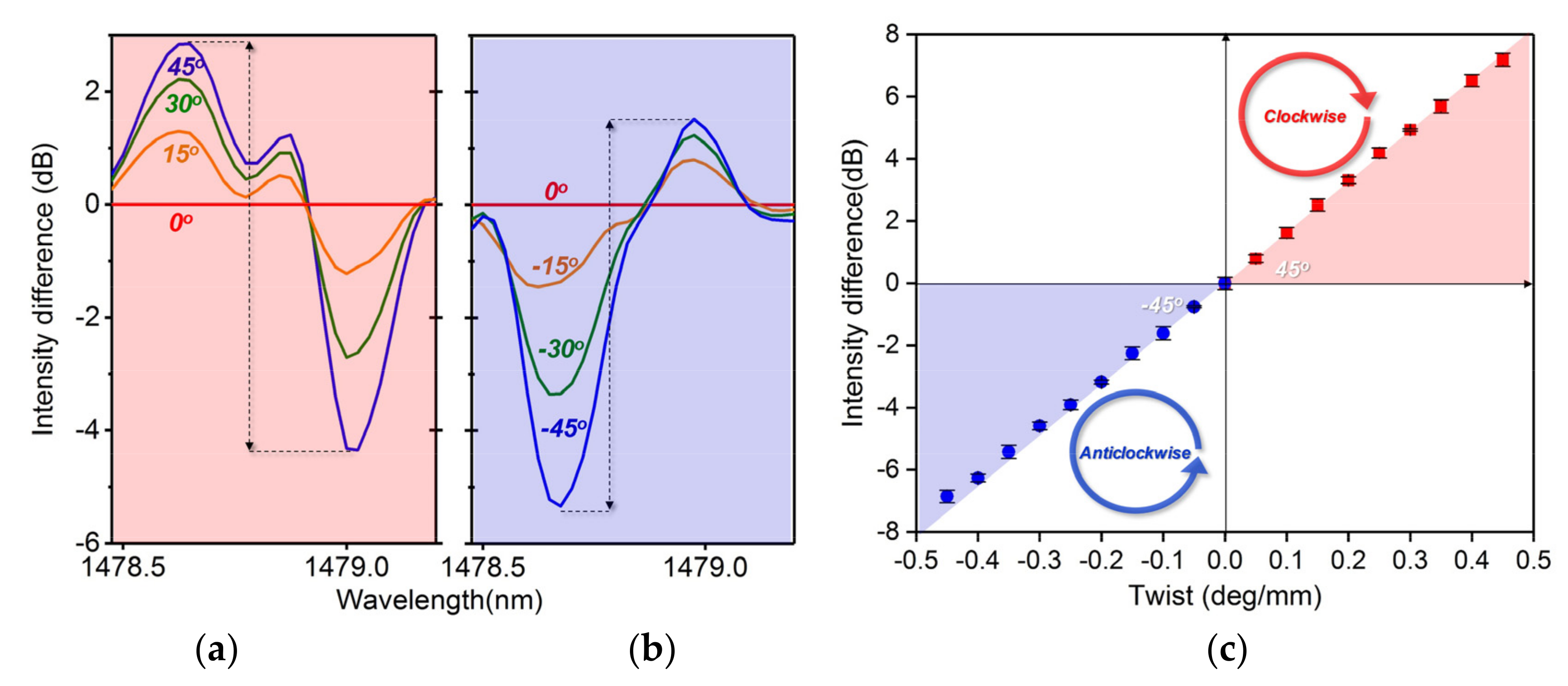
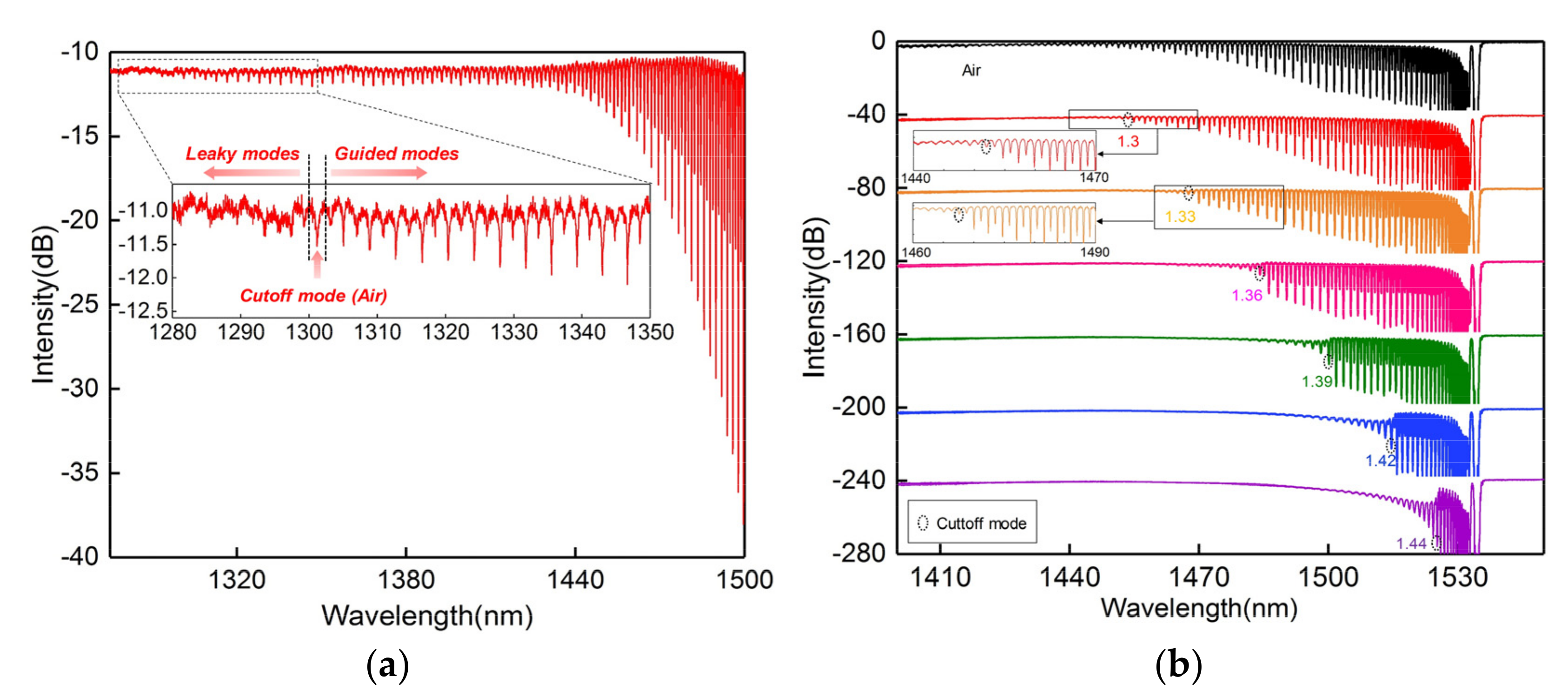
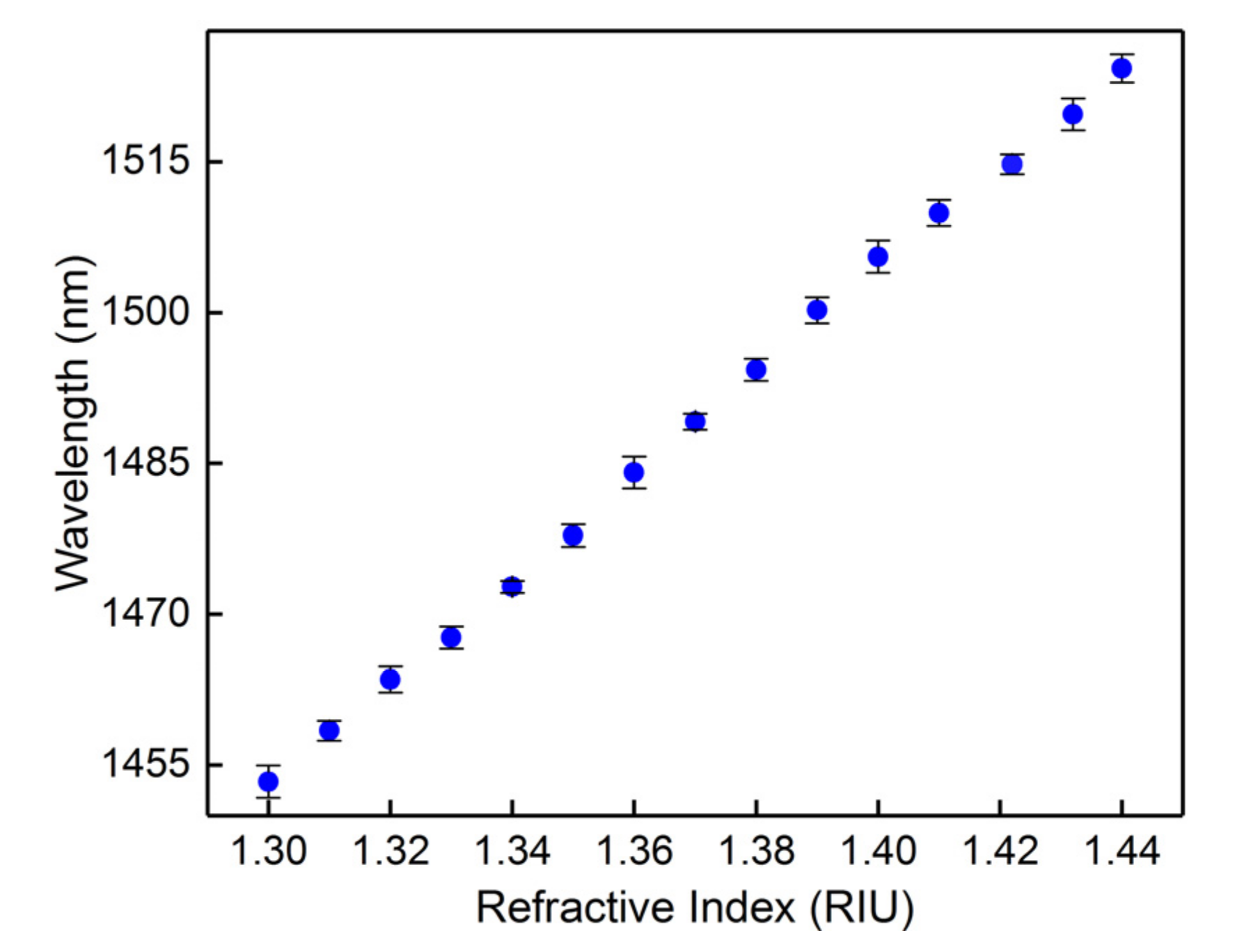
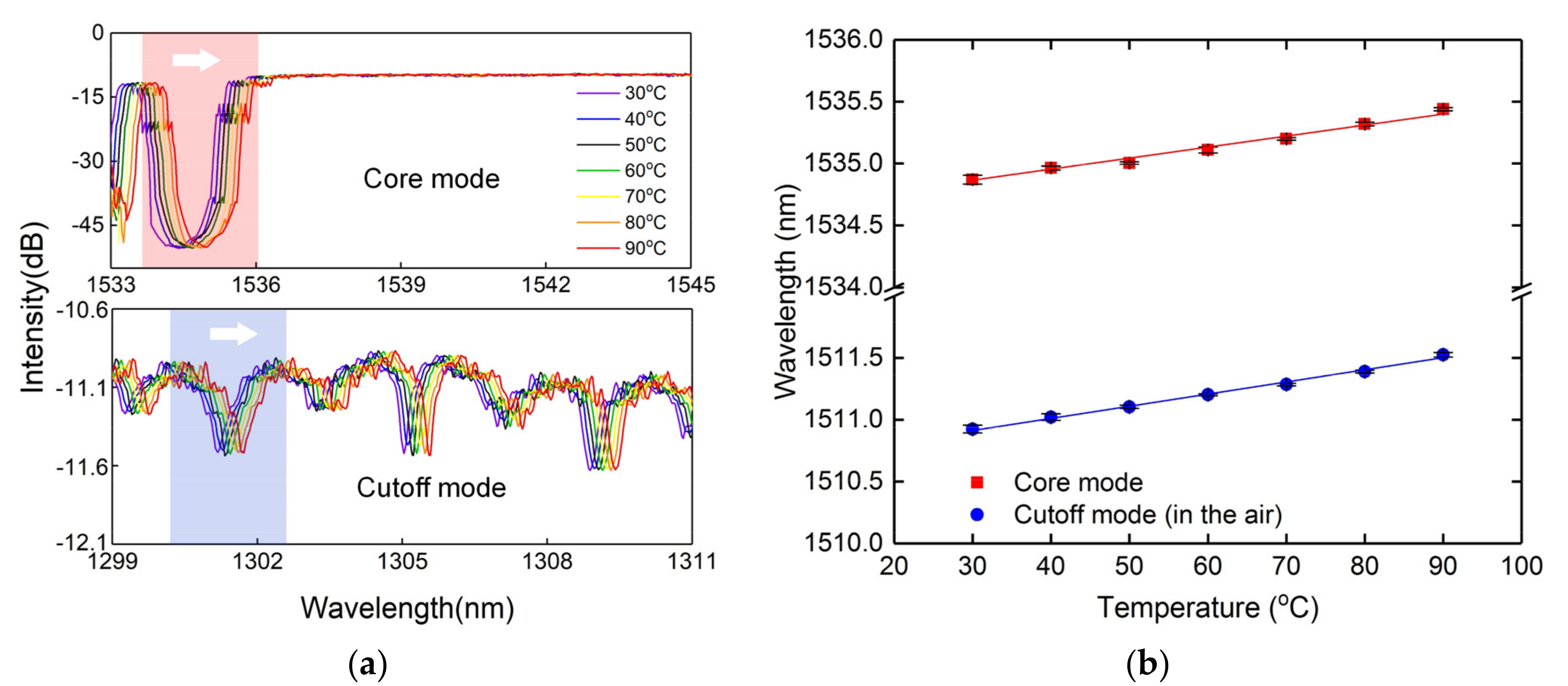
Publisher’s Note: MDPI stays neutral with regard to jurisdictional claims in published maps and institutional affiliations. |
© 2020 by the authors. Licensee MDPI, Basel, Switzerland. This article is an open access article distributed under the terms and conditions of the Creative Commons Attribution (CC BY) license (http://creativecommons.org/licenses/by/4.0/).
Share and Cite
Bao, W.; Liu, S.; Feng, W.; Wang, Y. Fiber Bragg Grating with Enhanced Cladding Modes Inscribed by Femtosecond Laser and a Phase Mask. Sensors 2020, 20, 7004. https://doi.org/10.3390/s20247004
Bao W, Liu S, Feng W, Wang Y. Fiber Bragg Grating with Enhanced Cladding Modes Inscribed by Femtosecond Laser and a Phase Mask. Sensors. 2020; 20(24):7004. https://doi.org/10.3390/s20247004
Chicago/Turabian StyleBao, Weijia, Shen Liu, Wenjie Feng, and Yiping Wang. 2020. "Fiber Bragg Grating with Enhanced Cladding Modes Inscribed by Femtosecond Laser and a Phase Mask" Sensors 20, no. 24: 7004. https://doi.org/10.3390/s20247004
APA StyleBao, W., Liu, S., Feng, W., & Wang, Y. (2020). Fiber Bragg Grating with Enhanced Cladding Modes Inscribed by Femtosecond Laser and a Phase Mask. Sensors, 20(24), 7004. https://doi.org/10.3390/s20247004





